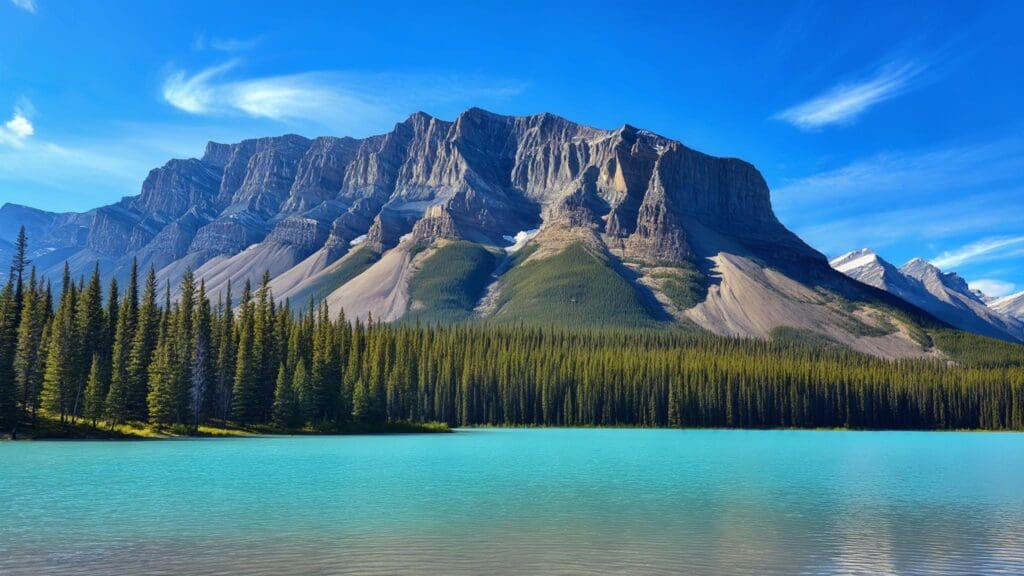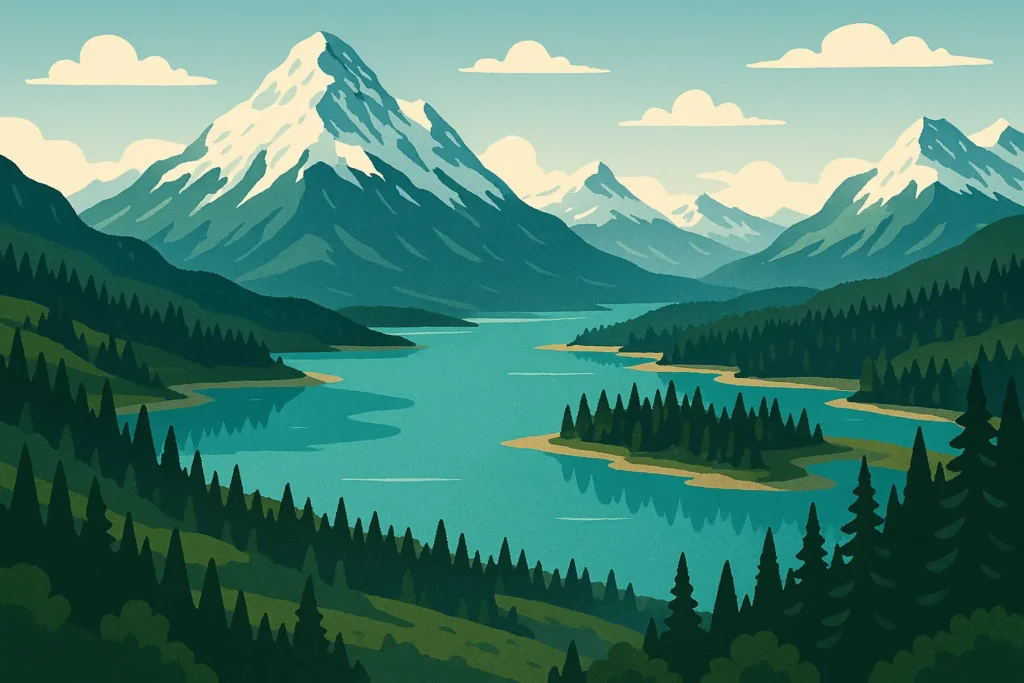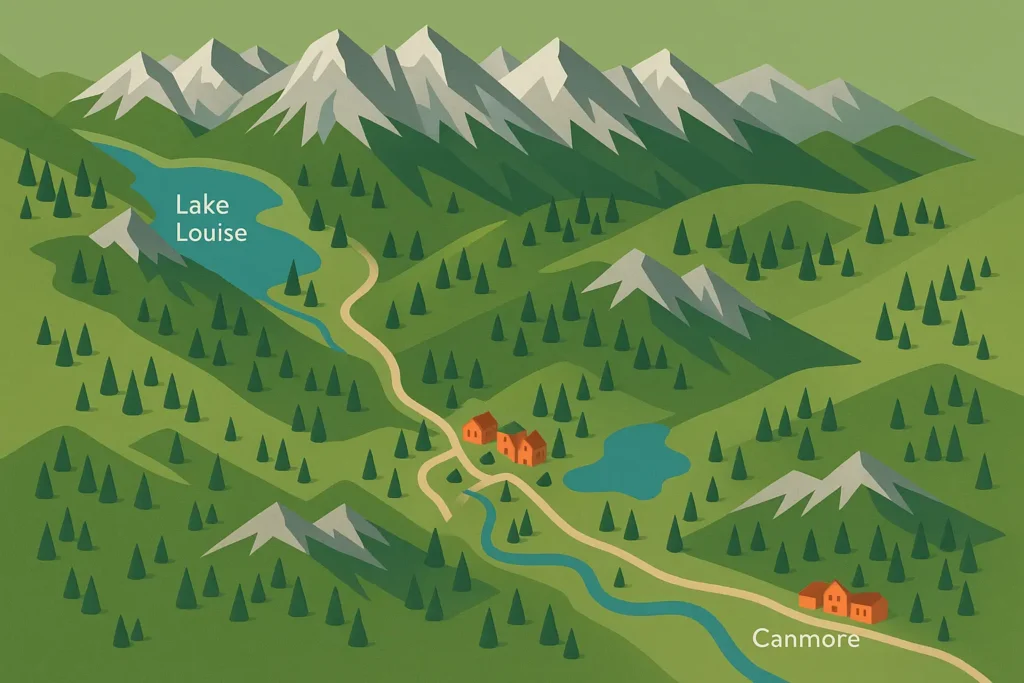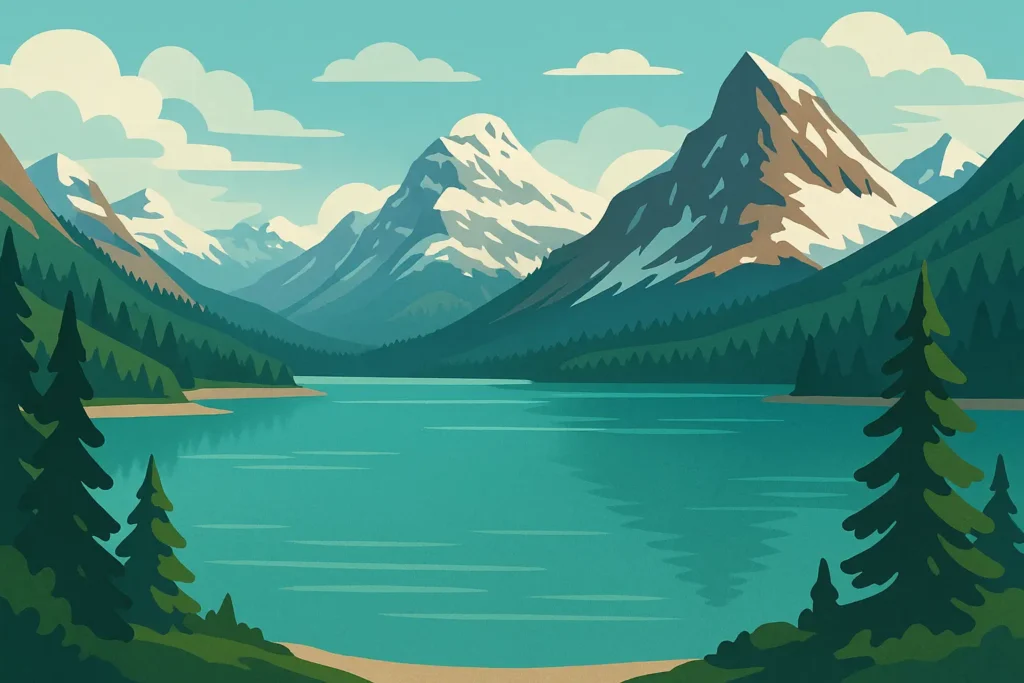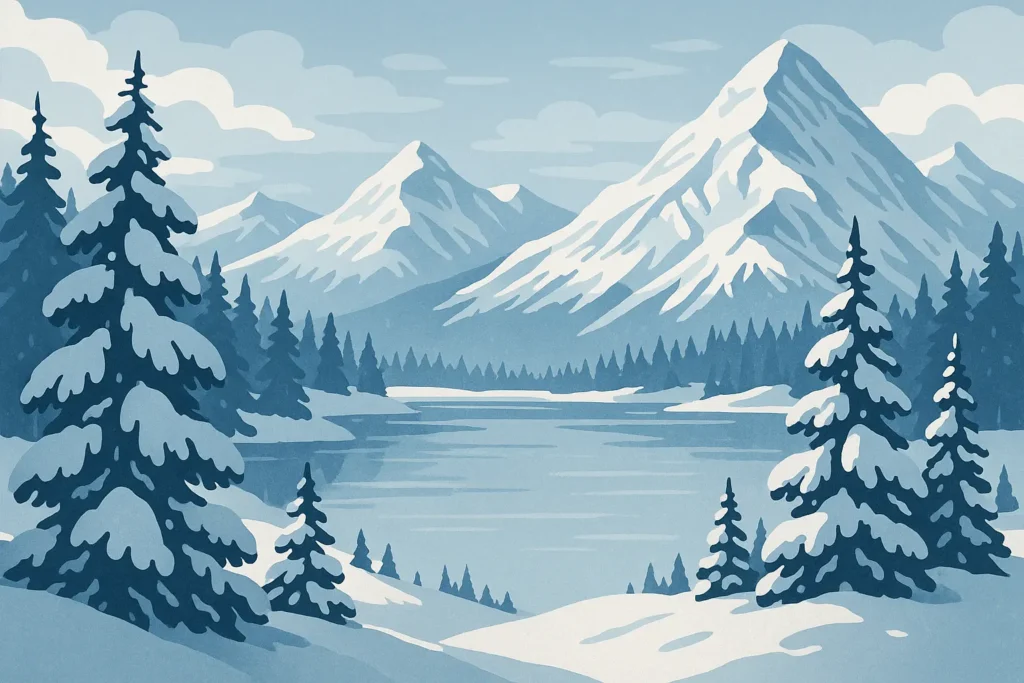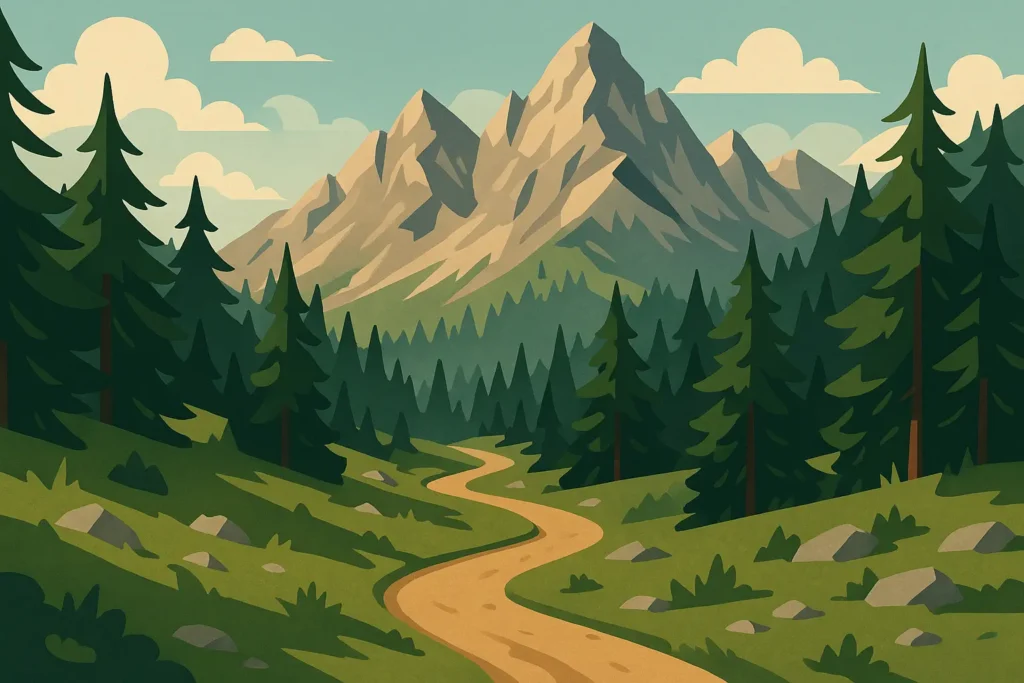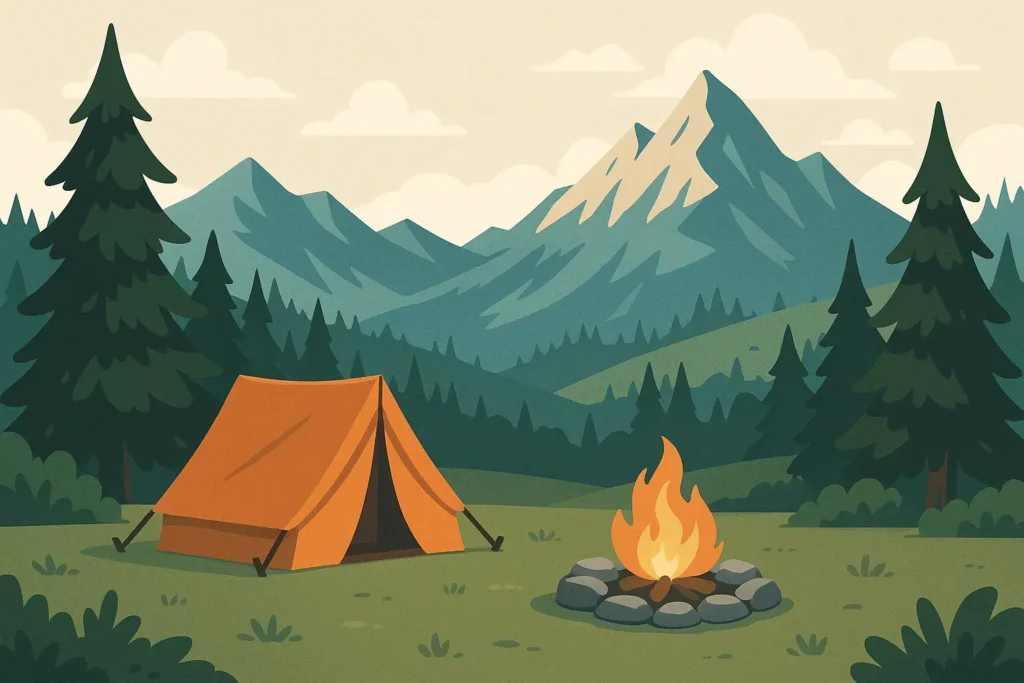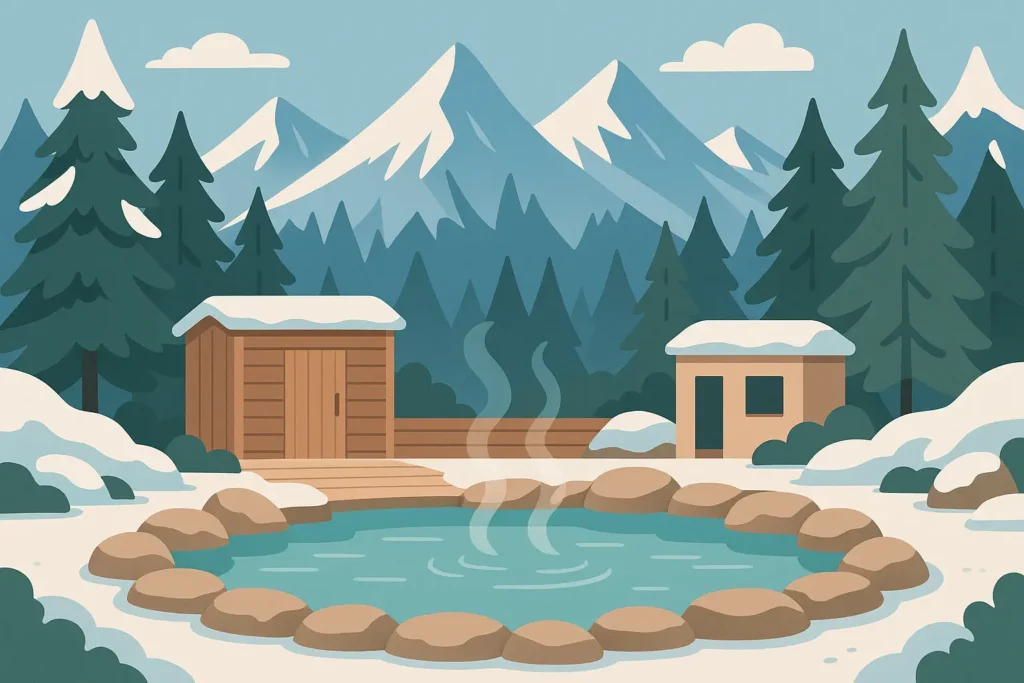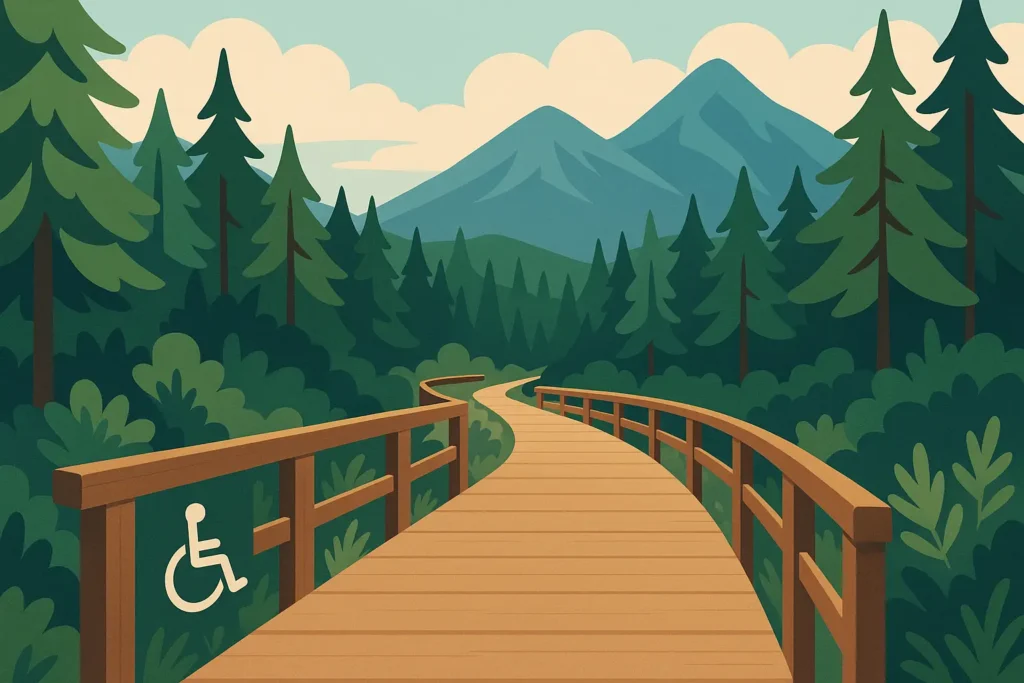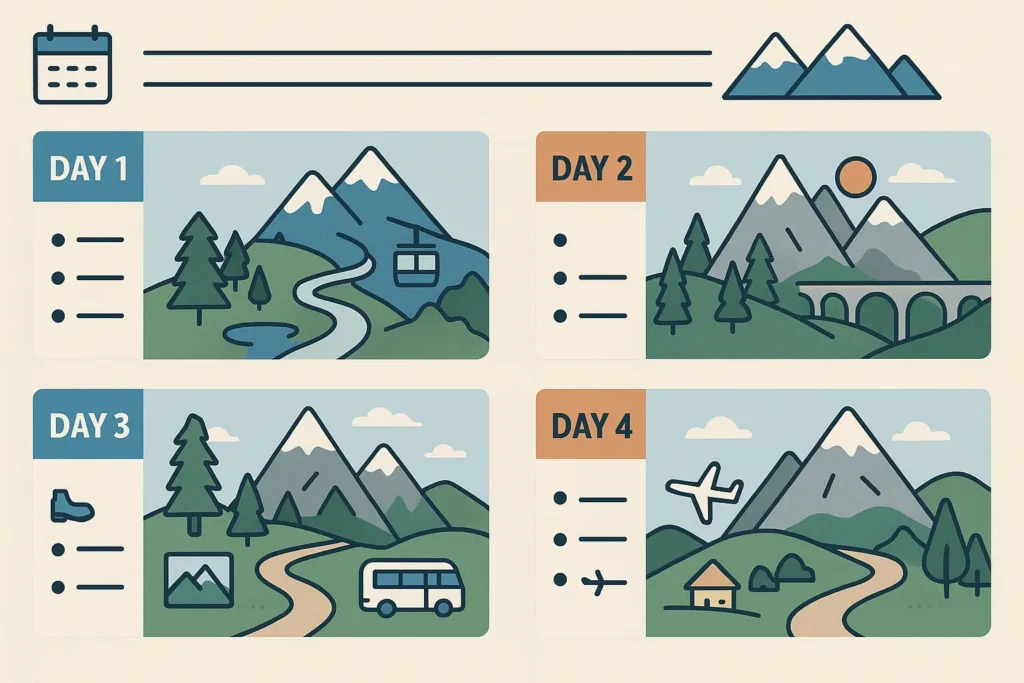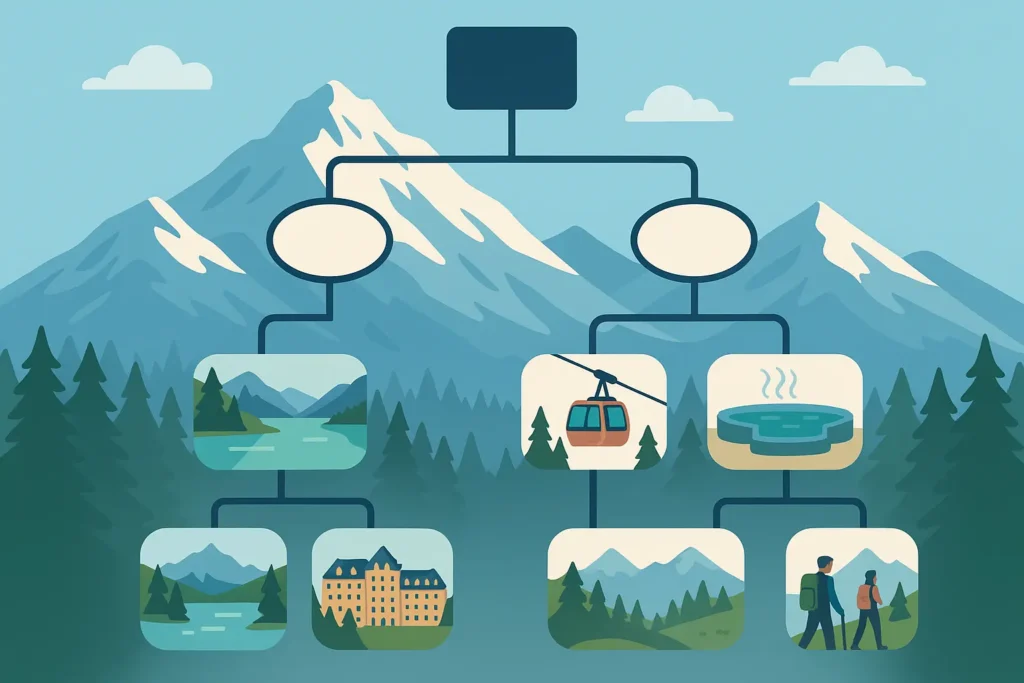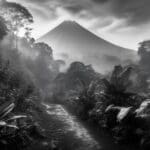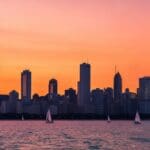Most people stay in either Canmore or Banff when visiting the Canadian Rockies, with Banff being closer to Lake Louise but way more touristy and expensive than Canmore. I discovered this the hard way during my first trip to the Rockies three years ago, when I spent hours scrolling through countless travel blogs, trying to piece together the perfect banff itinerary. The sheer number of options felt paralyzing – should I prioritize Lake Louise or Moraine Lake? How many days did I actually need? What if the weather didn’t cooperate?
Plan every detail with the AI Wedding Planner
That overwhelming planning experience taught me something valuable: having too many choices without clear guidance can turn dream trip planning into a stress-inducing nightmare. After helping dozens of friends plan their Banff adventures (and making plenty of mistakes along the way), I’ve learned that the secret isn’t finding the “perfect” itinerary – it’s finding the right one for your specific situation.
Quick Resources
Helpful tools to make your Banff adventure seamless and stress-free:
-
Planning a small ceremony in the Rockies? Try the Elopement Planner
-
Write vows or wedding speeches inspired by your mountain trip with the AI Wedding Speech Generator
TL;DR
- Duration matters more than you think – 4-7 days hits the sweet spot for most travelers
- Seasonal timing dramatically impacts both costs and available activities
- Budget planning should include accommodation, transportation, park passes, and activity fees
- Group dynamics and fitness levels determine which activities will work best
- Booking popular attractions and accommodations requires advance planning (sometimes months ahead)
- Weather flexibility is essential – mountain conditions change rapidly
- Base location choice (Banff townsite, Lake Louise, or Canmore) affects your entire experience
Planning Your Perfect Banff Adventure
Look, I get it – you want to know what actually matters when planning a trip to Banff without getting overwhelmed by a million different options. After helping tons of people plan their trips (and screwing up my own a few times), here’s what really makes or breaks a Banff adventure.
Duration & Timing Considerations
Trip length determines how much you can realistically experience without feeling like you’re sprinting through the mountains. Weekend trips work for first-time visitors wanting highlights, but honestly, you’ll spend more time driving than exploring. Four to seven days provides the sweet spot – enough time to see the major stuff while allowing for weather delays or those random discoveries that end up being the best part of your trip.
| Trip Duration | Best For | Pros | Cons | Recommended Activities |
|---|---|---|---|---|
| 2-3 Days | First-time visitors, limited vacation time | Quick highlights, lower cost | Rushed pace, limited flexibility | Lake Louise, Banff Gondola, Johnston Canyon |
| 4-5 Days | Most travelers | Balanced pace, weather flexibility | Moderate cost | All major attractions plus hiking |
| 6-7 Days | Adventure seekers, photographers | Comprehensive exploration, rest days | Higher cost, more planning | Backcountry options, multiple base locations |
| 7+ Days | Serious adventurers, extended vacations | Complete immersion, Jasper extension | Significant investment | Multi-day hikes, specialized workshops |
Here’s the thing about seasonal timing – it goes way beyond just weather preferences. Summer brings warm hiking conditions but also massive crowds and prices that’ll make you question your life choices. Winter offers unique activities but harsh conditions that can shut down half your plans. Spring provides pretty amazing wildlife viewing as animals emerge from winter, though many high-elevation trails are still buried in snow. Fall delivers gorgeous colors and fewer crowds, but weather becomes increasingly unpredictable.
Mountain weather changes fast regardless of season. I’ve experienced sunshine in Canmore while getting caught in thunderstorms an hour away in Lake Louise. Building flexibility into your banff itinerary prevents disappointment when conditions force plan changes – and trust me, they will.
Activity Preferences & Fitness Assessment
Be honest with yourself about your group’s physical capabilities. I’ve seen too many trips turn into disasters because someone planned like they were training for a marathon when they barely walk around the block at home. High-energy adventures require excellent fitness and outdoor experience. Moderate activities suit most reasonably active adults. Low-impact options accommodate various mobility levels.
Sarah’s Family Planning Reality Check: When Sarah planned her Banff trip for her family of four (ages 8-65), she initially wanted to hike to Plain of Six Glaciers. After honestly assessing her father’s mobility limitations and her 8-year-old’s attention span, she switched to Lake Agnes Tea House – a shorter, more manageable hike that still provided mountain adventure and refreshments. The result? Everyone enjoyed the experience instead of struggling through an overly ambitious plan.
Interest diversity within travel groups requires compromise and creative planning. Adventure seekers might want challenging scrambles while others prefer leisurely photography sessions. Successful itineraries balance different preferences rather than forcing everyone into identical activities.
Budget Planning Essentials
Let’s talk money for a second because Banff isn’t cheap. A decent hotel in Banff townsite will run you $300-400 CAD per night in summer. Yeah, it hurts. That’s why a lot of people stay in Canmore – you’ll save about $100 per night and the drive to the park is only 20 minutes.
Transportation expenses include rental cars (pretty much essential), gas, and potential guided tour costs. Public transportation exists but it’s not great if you want to hit multiple spots in a day. Equipment rentals for activities add up quickly too.
Here’s what stuff actually costs:
- Park pass: $20/day per vehicle (just get the annual for $70 if you’re staying more than 3 days)
- Banff Gondola: $65 per adult (ouch, but the views are legit)
- Lake Louise canoe: $120/hour (worth it once, maybe not twice)
Group Dynamics & Logistics
Travel party size affects everything from hotel bookings to restaurant reservations. Larger groups face challenges securing adjacent hotel rooms. Small groups enjoy more flexibility but may miss group discounts.
Traveling with different fitness levels? I’ve seen this go sideways so many times. Someone always wants to do the ‘easy’ hike that turns out to be 8km uphill. Have an honest conversation about what everyone can actually handle before you get there.
Base location choice influences your entire experience. Banff townsite offers walkable amenities and central location but higher costs. Lake Louise provides immediate access to iconic lakes but limited dining options. Canmore delivers better value with slightly longer drives to major attractions.
Duration-Based Banff Itineraries
Duration-based itineraries give you a framework for different trip lengths, from quick weekend getaways to comprehensive week-long explorations. Each timeframe has distinct advantages and limitations – shorter trips focus on must-see highlights while longer stays allow for deeper exploration and those spontaneous discoveries that often end up being the best parts.
Customize your romantic getaway using our Honeymoon Planner
1. Weekend Warrior (2-3 Days)
Perfect for time-pressed travelers making their first Banff visit, this condensed banff itinerary maximizes limited time while providing essential mountain experiences. You’ll hit the major highlights without feeling completely rushed, though expect full days and minimal downtime.
You’ll probably be tired from traveling, so don’t plan anything crazy for day one. The drive from Calgary is about 90 minutes if traffic cooperates (which it doesn’t always). Grab some groceries, walk around town, maybe hit up a patio for a beer. Save your energy for tomorrow.
Day two delivers the iconic Lake Louise experience. Early morning arrival beats crowds and provides optimal lighting for photography. If accessible (seasonal road closures affect availability), Moraine Lake offers equally stunning scenery with different perspectives. The Lake Agnes Tea House hike provides moderate exercise with rewarding mountain views and refreshments.
Day three combines panoramic vistas with accessible attractions. The Banff Gondola offers spectacular mountain views without hiking requirements, making it perfect for various fitness levels. Bow Falls and Surprise Corner provide classic photo opportunities with minimal walking. This structure allows for flexible departure timing.
2. Classic Week (4-5 Days)
This duration hits the sweet spot for most travelers, providing comprehensive coverage without exhaustion. You’ll experience major attractions while maintaining reasonable pacing that allows for weather delays or spontaneous discoveries.
Days one and two establish your Banff base with townsite exploration and nearby attractions. The Banff Gondola provides orientation and pretty amazing views, while Banff Upper Hot Springs offer relaxation after travel. Johnston Canyon delivers accessible hiking with impressive waterfalls, and the Bow Valley Parkway scenic drive includes wildlife viewing opportunities.
Days three and four shift focus to the Lake Louise area. Lake Louise canoeing provides intimate water experiences, while the Fairmont Chateau offers luxury amenities and dining. Moraine Lake (when accessible) delivers postcard-perfect scenery, and the Valley of Five Lakes hike provides moderate exercise with diverse alpine scenery. The Plain of Six Glaciers trail offers more challenging hiking for those seeking adventure.
Day five explores the famous Icefields Parkway, either as a day trip or beginning of Jasper extension. Athabasca Falls provides impressive water features, while the Columbia Icefield experience offers unique glacier access. This flexible structure accommodates various interests and energy levels.
3. Extended Explorer (6-7 Days)
Extended stays allow for comprehensive exploration including backcountry adventures and deeper cultural experiences. This timeframe accommodates weather delays while providing opportunities for spontaneous discoveries and rest days.
The first two days focus on acclimatization and townsite exploration. Gentle activities help with altitude adjustment. Hot springs provide relaxation while downtown exploration offers cultural experiences and shopping opportunities.
Days three and four dive deep into Lake Louise experiences. Beyond standard lake visits, you’ll have time for multiple hiking options including Lake Agnes Tea House, Big Beehive, and Larch Valley (seasonal). Evening hours at Fairmont Chateau provide luxury experiences and fine dining opportunities.
Days five and six introduce backcountry adventures for experienced hikers. Multi-day options provide wilderness experiences with comfortable accommodations. Alternative day hikes include challenging scrambles or photography-focused explorations.
The final day allows for Icefields Parkway exploration or Jasper National Park extension. Multiple stops and short hikes provide diverse experiences, while glacier access offers unique educational opportunities.
4. Long Weekend Luxury (3-4 Days)
Designed for travelers seeking premium experiences within limited timeframes, this approach emphasizes quality over quantity. You’ll enjoy exclusive access and luxury amenities while experiencing Banff’s natural beauty.
Planning a small ceremony in the Rockies? Try the Elopement Planner
Day one establishes luxury accommodations at properties offering premium amenities. Spa treatments provide relaxation after travel, while fine dining introduces local cuisine. Evening hours include premium cocktails with mountain views.
Day two focuses on exclusive Lake Louise experiences. Private helicopter tours offer unique perspectives, while exclusive canoeing provides intimate water experiences. Afternoon tea delivers luxury amenities with gorgeous scenery.
Days three and four combine personalized adventures with ultimate relaxation. Private guided tours cater to specific interests. Gourmet picnics in scenic locations provide memorable dining experiences, while spa treatments offer complete relaxation.
5. Ultimate Banff Experience (7+ Days)
Comprehensive exploration for serious adventurers seeking complete Banff immersion. This extended timeframe allows for challenging backcountry adventures, multiple base locations, and thorough exploration of surrounding areas.
The first two days provide gentle acclimatization with townsite exploration and easy hiking. Hot springs provide relaxation and cultural experiences.
Days three and four deliver comprehensive Lake Louise exploration including multiple hiking options and luxury experiences. Various trails provide diverse hiking challenges, while premium amenities offer comfort between adventures.
Days five and six introduce serious backcountry adventures. Multi-day hiking with lodge accommodations or camping provides wilderness immersion. Advanced trails challenge experienced hikers, while photography workshops offer skill development.
Day seven explores the complete Icefields Parkway with multiple stops and extended hiking opportunities. Glacier experiences provide unique educational opportunities, while scenic drives offer relaxation between activities.
Additional days allow for Jasper National Park extension, specialized activities, or wellness retreats.
Seasonal Banff Experiences
Seasonal itineraries capitalize on unique opportunities available during specific times of year, from summer’s hiking paradise to winter’s snow-covered wonderland. Each season offers distinct advantages and challenges, with activities, pricing, and accessibility varying dramatically throughout the year.
6. Summer Adventure Seeker
Summer transforms Banff into a hiking paradise with long daylight hours and accessible high-elevation trails. However, peak season brings massive crowds and premium pricing that require strategic planning and early bookings.
Early morning starts become essential for popular destinations. Moraine Lake parking fills up by 6 AM in summer. Not 8 AM, not 7 AM – 6 AM. If you’re not a morning person, maybe skip it or take the shuttle when it’s running. The Instagram shot isn’t worth the parking stress.
High-elevation trails become accessible as snow melts, typically by late June. Wildflower displays peak in July and August, creating pretty amazing photography opportunities. Alpine lakes reach their most vibrant turquoise colors during summer months.
Mike’s Summer Strategy Success: Mike learned from his first crowded Banff visit to wake up at 4:30 AM for his second trip. By reaching Moraine Lake before 6 AM, he captured the famous reflection shot in perfect stillness, had the viewpoint mostly to himself, and completed the Rockpile Trail before crowds arrived. His early sacrifice resulted in pristine photos and peaceful mountain moments that justified the early alarm.
I cannot stress this enough: book your accommodations as soon as you know your dates. I’ve seen people pay $500/night for sketchy motels because they waited until a month before. Summer spots get booked by February. Restaurant reservations become essential for fine dining establishments too.
Wildlife activity increases with longer daylight hours, but animals often retreat to cooler elevations during hot afternoons. Early morning and evening hours provide optimal viewing opportunities along scenic drives.
7. Winter Wonderland
Winter transforms Banff into a snow-covered paradise offering unique activities unavailable during other seasons. Winter in Banff is no joke though. I’m talking -30°C cold where your phone dies in 10 minutes. It’s beautiful, but make sure you actually want to deal with that level of cold before booking a February trip.
Skiing and snowboarding take center stage with three world-class resorts: Lake Louise Ski Resort, Sunshine Village, and Mount Norquay. Each offers different terrain and experiences, from beginner-friendly slopes to expert-level challenges. Equipment rentals and lessons accommodate all skill levels.
Ice walking at Johnston Canyon provides magical winter experiences as waterfalls freeze into incredible ice formations. Professional guides provide safety equipment and instruction for navigating icy conditions. The experience offers unique photography opportunities unavailable during warmer months.
Dog sledding, snowmobiling, and cross-country skiing provide alternative winter adventures. These activities require advance booking and appropriate clothing for sub-zero temperatures. Many operators provide equipment and instruction for beginners.
Lake Louise ice skating offers romantic winter experiences on the frozen lake surface, with mountain backdrops providing gorgeous scenery. Ice sculpture displays and winter festivals add cultural elements to outdoor adventures.
Hot springs become especially appealing during winter months, providing warm relaxation after cold outdoor activities. Banff Upper Hot Springs offers year-round operation with stunning mountain views from heated pools.
8. Fall Colors & Fewer Crowds
September and October provide gorgeous autumn colors with significantly fewer crowds and reduced accommodation rates. Cooler temperatures make hiking more comfortable, while golden aspen and larch trees create photographer’s paradise conditions.
Larch Valley becomes the star attraction during late September when alpine larch trees turn brilliant gold. This short seasonal window (typically 2-3 weeks) draws photographers from around the world. Early morning visits provide optimal lighting and fewer crowds.
Moraine Lake experiences reduced visitor numbers while maintaining gorgeous scenery. The famous turquoise waters contrast beautifully with golden aspen trees along shorelines. Canoeing becomes more peaceful without summer’s constant activity.
| Season | Best Activities | Crowd Level | Accommodation Rates | Weather Considerations |
|---|---|---|---|---|
| Summer (Jun-Aug) | Hiking, canoeing, all trails accessible | Very High | Premium pricing | Long days, afternoon thunderstorms |
| Winter (Dec-Mar) | Skiing, ice walking, hot springs | Low | Lowest rates | Short days, extreme cold, snow gear required |
| Fall (Sep-Oct) | Larch viewing, photography, comfortable hiking | Moderate | Mid-range | Variable weather, early snow possible |
| Spring (Apr-May) | Wildlife viewing, fewer crowds, shoulder rates | Low-Moderate | Shoulder pricing | Unpredictable, high elevation trails closed |
Accommodation rates drop significantly compared to peak summer pricing, making luxury properties more accessible. Restaurant reservations become easier to secure, and popular attractions experience shorter wait times.
Weather becomes more variable with potential for early snowfall at high elevations. August in the Rockies can hit 30°C in town and be snowing at higher elevations. I’m not kidding – I’ve seen people in flip-flops at Lake Louise while there’s snow on the peaks. Pack like you’re going to three different climates.
Wildlife activity increases as animals prepare for winter, providing excellent viewing opportunities. Elk bugling season creates unique audio experiences, while bears become more active feeding before hibernation.
9. Spring Awakening
Spring offers unique advantages including excellent wildlife viewing, lower accommodation rates, and fewer crowds. However, unpredictable weather and limited high-elevation access require flexible planning approaches.
Everyone wants to see bears and elk, but wildlife spotting is hit or miss. Early morning and evening are your best bets, and the Bow Valley Parkway is usually good for elk. But don’t plan your whole trip around seeing specific animals – nature doesn’t work that way.
Lower elevation trails become accessible while high-elevation options remain snow-covered. Johnston Canyon Lower Falls provides amazing spring runoff displays, while Fenland Trail offers gentle walking with excellent bird watching opportunities.
Lake Louise remains frozen well into spring, creating unique photographic opportunities different from summer’s turquoise waters. The Fairmont Chateau provides indoor activities and amenities when weather doesn’t cooperate with outdoor plans.
Accommodation rates remain at shoulder season levels, providing significant savings compared to summer pricing. Restaurant availability improves compared to winter’s limited options, though some seasonal establishments may not yet be open.
Weather unpredictability requires flexible itineraries with indoor backup options. Mountain weather is weird, guys. I’ve packed shorts for a July hike and ended up in a hailstorm. Always bring layers, even if the forecast looks perfect.
Activity-Focused Mountain Adventures
Activity-focused itineraries cater to specific interests and skill levels, from challenging multi-day backpacking adventures to gentle family-friendly explorations. These specialized approaches ensure your trip aligns with your primary interests while providing appropriate challenge levels and safety considerations.
10. Hiking & Backpacking
Serious hiking enthusiasts require itineraries that progress from acclimatization to challenging adventures. This approach builds fitness and confidence while providing amazing wilderness experiences for those seeking authentic mountain adventures.
Days one and two focus on acclimatization with moderate day hikes. Tunnel Mountain provides excellent views with manageable elevation gain, while C-Level Cirque offers mountain goat viewing opportunities. These hikes help assess group fitness levels and adjust expectations for more challenging adventures.
Days three and four introduce multi-day backcountry experiences for properly equipped and experienced hikers. Egypt Lake backcountry camping provides wilderness immersion with gorgeous alpine scenery. Pharaoh Lake and Scarab Lake exploration offers solitude and pristine wilderness experiences unavailable to day hikers.
Days five and six challenge experienced hikers with technical scrambles and advanced day hikes. Mount Temple (3,543m) requires scrambling skills and excellent fitness but rewards climbers with amazing summit views. Sentinel Pass via Larch Valley provides alpine adventure with seasonal larch displays.
The final day offers celebration hiking with comfortable amenities. Lake Agnes Tea House provides rewarding refreshments after moderate hiking, while Big Beehive adds optional challenge for those seeking extra adventure.
11. Photography & Scenic Drives
If you’re into photography, here’s the deal: golden hour is your friend, but it means getting up stupid early. Most of the iconic shots happen before 7 AM when the lakes are still and the light is soft.
Day one focuses on Banff townsite photography opportunities. Golden hour shots of Cascade Mountain provide dramatic lighting, while Bow River reflections offer water feature compositions. Banff Avenue street photography captures local culture, and Surprise Corner delivers classic sunset opportunities.
Day two concentrates on Lake Louise mastery with multiple lighting conditions. Blue hour and sunrise photography provide optimal lighting with fewer crowds. Various angle exploration around the lake offers composition diversity, while Fairmont Chateau architecture provides structural elements for varied shots.
Day three explores Moraine Lake’s photographic potential. Fair warning: Lake Louise in summer looks nothing like those pristine Instagram photos unless you’re there at sunrise. It’s still beautiful, but expect crowds and maybe some construction equipment in your shots.
Day four tackles the Icefields Parkway’s numerous photographic opportunities. Bow Lake reflections offer mirror-perfect compositions, while Peyto Lake overlook provides iconic turquoise water shots. Athabasca Falls delivers dynamic water photography, and glacier shots provide unique ice formations.
Day five discovers hidden photographic gems. Herbert Lake offers perfect mirror reflections with fewer crowds than famous locations. Bow Valley Parkway provides wildlife photography opportunities, while Two Jack Lake delivers alternative perspectives.
12. Family-Friendly Fun
Multi-generational groups require careful activity selection ensuring engagement across age ranges while providing backup options for weather or energy challenges. This approach balances adventure with accessibility for successful family bonding experiences.
Day one provides gentle introduction with indoor backup options. Banff Park Museum offers educational experiences during poor weather, while Bow River walks include playground stops for children. Ice cream on Banff Avenue provides treats while exploring downtown amenities.
Day two focuses on accessible lake adventures. Lake Louise canoeing offers family-friendly water activities with rental equipment available. Shoreline walks provide gentle exercise with gorgeous scenery, while Fairmont Chateau exploration offers luxury amenities and indoor spaces.
The Johnson Family Success Story: With kids aged 6 and 12, plus grandparents in their 70s, the Johnsons thought Banff might be too challenging. They chose the Banff Gondola for mountain views without hiking, Johnston Canyon’s paved lower trail for waterfall excitement, and Lake Louise canoeing with life jackets provided. The grandparents rested at Fairmont Chateau while parents and kids explored, then everyone reunited for afternoon tea. Result: three generations created lasting memories together.
Day three introduces gentle hiking appropriate for children. Johnston Canyon Lower Falls requires only 1.1 km easy walking on paved pathways. Bow Valley Parkway wildlife spotting provides educational opportunities, while Cave and Basin hot springs offer historical experiences with warm water relaxation.
Day four emphasizes scenic drives with minimal walking requirements. Moraine Lake (when accessible) provides gorgeous scenery with short walks from parking. Lake Minnewanka boat cruises offer unique perspectives without hiking requirements, while Banff Gondola provides mountain views with wheelchair accessibility.
13. Luxury & Relaxation
High-end travelers seeking premium experiences require itineraries emphasizing exclusive access, luxury amenities, and personalized service. This approach maximizes comfort while providing unique mountain experiences unavailable to budget travelers.
Day one establishes luxury accommodations at premium properties offering world-class amenities. Spa treatments provide relaxation after travel, while fine dining introduces local cuisine with mountain views. Evening cocktails with panoramic vistas complete the luxury introduction.
Day two offers exclusive Lake Louise experiences. Private helicopter tours provide unique aerial perspectives unavailable to ground-based visitors. Exclusive canoeing experiences offer intimate water activities, while afternoon tea delivers luxury amenities with gorgeous scenery.
Day three combines personalized adventures with ultimate relaxation. Private guided photography tours cater to individual interests and skill levels. Gourmet picnics in scenic locations provide memorable dining experiences, while personal shopping time allows for souvenir acquisition and relaxation.
Day four focuses on ultimate relaxation and reflection. Full spa days provide comprehensive wellness experiences. Private dining experiences offer exclusive culinary adventures, while sunset viewing from premium locations provides amazing finale experiences.
14. Adventure Sports Extreme
Adrenaline junkies require itineraries featuring technical activities and extreme sports. This approach demands excellent physical condition, previous experience, and professional instruction for safety during high-risk activities.
Day one introduces rock climbing with accessible via ferrata experiences. Grassi Lakes via ferrata provides technical climbing introduction with safety systems. Equipment rental and professional instruction ensure proper technique development, while evening recovery allows for planning more challenging adventures.
Day two escalates to ice climbing (winter) or multi-pitch rock climbing (summer). Guided ice climbing at Johnston Canyon provides unique winter experiences with professional instruction. Multi-pitch rock climbing at Tunnel Mountain offers summer alternatives requiring advanced skills and safety knowledge.
Day three focuses on mountain biking adventures. Tunnel Mountain bike trails provide technical single-track experiences, while Bow Valley Parkway cycling offers scenic alternatives. You don’t need $200 hiking boots for most Banff trails. Decent running shoes work fine for the popular hikes. Save your money for a good rain jacket – mountain weather changes fast and getting soaked sucks.
Day four challenges participants with extreme hiking adventures. Mount Temple scramble requires advanced hiking skills and scrambling experience. Via Ferrata at Mount Norquay provides alternative technical challenges with safety equipment and professional guidance.
Day five introduces water sports adventures. Whitewater rafting on Kicking Horse River provides adrenaline-pumping experiences, while kayaking on Bow River offers gentler water adventures. Weather-dependent alternatives ensure backup options for challenging conditions.
Budget-Conscious Banff Options
Budget-focused itineraries prove that amazing Banff experiences don’t require premium spending. These approaches emphasize free natural attractions, budget accommodations, and cost-effective transportation while maintaining high-quality experiences.
15. Budget Backpacker
Cost-conscious travelers can experience Banff’s natural beauty through strategic planning emphasizing free attractions and budget accommodations. This approach requires more preparation but delivers authentic mountain experiences at fraction of luxury costs.
Accommodation at HI-Banff Alpine Centre or designated campgrounds provides affordable lodging with social opportunities. Hostel common areas facilitate meeting fellow travelers, while camping offers authentic outdoor experiences. Advanced booking ensures availability during peak seasons.
Renting a car is pretty much essential unless you’re okay with very limited options. The public transit exists but it’s not great for hitting multiple spots in a day. Split the rental cost with your group – it’s worth it for the flexibility.
Day one focuses on free Banff exploration. Self-guided townsite walking tours provide historical and cultural education without guide costs. Bow Falls offers gorgeous scenery accessible via short walks from free parking areas. Surprise Corner viewpoint provides classic mountain photography opportunities without admission fees.
Day two emphasizes low-cost Lake Louise experiences. Early morning visits avoid parking fees while providing optimal lighting conditions. Look, Banff restaurant prices will make you cry a little. A decent dinner for two easily hits $150+ with drinks. If you’re trying to save money, hit up Safeway for sandwich supplies and eat with million-dollar views instead.
Day three concentrates on hiking adventures using only national park pass access. Johnston Canyon provides amazing waterfall experiences, while Tunnel Mountain trail offers panoramic views. Packed meals and snacks eliminate food service costs while providing energy for extended outdoor activities.
Day four extends adventures with strategic day trip planning. Moraine Lake early morning visits provide iconic scenery, while Valley of Five Lakes hike offers diverse alpine experiences. Pro tip I learned the hard way: those beautiful lakeside picnic spots you see in photos? They’re usually freezing cold even in summer because of the glacier runoff. Pack a blanket and maybe a thermos of something warm.
16. Mid-Range Explorer
Balanced budgets allow for comfortable accommodations and selective splurges while maintaining cost consciousness. This approach provides quality experiences without luxury pricing through strategic spending and advance planning.
Accommodation selection balances comfort with cost through mid-range hotels or vacation rentals. Properties in Canmore often provide better value than Banff townsite locations while maintaining easy park access. Group accommodations with kitchen facilities reduce meal costs through self-catering options.
Transportation includes rental car costs shared among group members, providing flexibility for remote location access. Gas expenses and parking fees factor into daily budgets, while advance booking secures better rental rates.
Activity selection mixes free natural attractions with selective paid experiences. One major splurge provides memorable experiences, while hiking and scenic drives fill remaining time with amazing free activities.
Dining strategies combine restaurant meals with picnic lunches and hotel breakfast options. Local grocery shopping provides snacks and lunch supplies, while dinner reservations at mid-range restaurants offer local cuisine experiences without premium pricing.
17. Camping & Outdoor Focus
Camping-based itineraries provide authentic outdoor experiences while minimizing accommodation costs. This approach requires proper equipment and outdoor skills but delivers immersive wilderness experiences with significant cost savings.
Campground selection requires advance booking exactly five months ahead for popular locations. Tunnel Mountain and Two Jack Lake campgrounds provide convenient Banff access, while backcountry camping offers wilderness immersion for experienced outdoor enthusiasts.
Equipment needs include proper camping gear, cooking supplies, and weather-appropriate clothing. Rental options exist for visitors without personal equipment, though costs can add up quickly for extended stays.
Day activities emphasize hiking, wildlife viewing, and outdoor skill development. Campfire programs provide evening entertainment, while stargazing offers amazing night sky experiences unavailable in urban environments.
Meal planning focuses on camp cooking with portable stoves and cooler storage. Grocery shopping for camping supplies requires planning for limited refrigeration and cooking facilities. Group meal preparation can reduce individual costs while building social experiences.
18. Free & Low-Cost Activities
Maximizing national park pass value through free attractions and self-guided experiences proves that amazing mountain adventures don’t require expensive add-ons. This approach emphasizes natural beauty access and outdoor activities.
| Activity | Cost | Duration | Difficulty Level | Best Season |
|---|---|---|---|---|
| Johnston Canyon Lower Falls | Park pass only | 1-2 hours | Easy | Year-round |
| Tunnel Mountain Hike | Park pass only | 2-3 hours | Moderate | Spring-Fall |
| Bow Valley Parkway Wildlife Drive | Park pass + gas | 2-4 hours | Easy | Year-round |
| Lake Louise Shoreline Walk | Park pass only | 1-2 hours | Easy | Spring-Fall |
| Bow Falls Viewpoint | Park pass only | 30 minutes | Easy | Year-round |
| Surprise Corner Viewpoint | Park pass only | 15 minutes | Easy | Year-round |
Hiking trails provide unlimited free entertainment with gorgeous scenery. Various trails offer diverse experiences without additional costs beyond park pass requirements. Trail maps and self-guided information provide educational elements without guide fees.
Scenic drives offer amazing mountain scenery accessible by vehicle. Multiple pullouts and viewpoints provide photography opportunities and short walks without hiking requirements.
Wildlife viewing along designated areas provides exciting experiences without guide costs. Early morning and evening hours offer optimal animal activity periods. Binoculars enhance viewing experiences without significant equipment investment.
Self-guided tours using available information resources provide educational experiences without guide costs. Townsite walking tours, historical site visits, and interpretive displays offer cultural learning opportunities.
Lake access for photography, picnicking, and relaxation provides hours of free entertainment. Multiple lakes offer gorgeous scenery with minimal walking requirements from parking areas.
Special Interest Itineraries
Specialized itineraries cater to specific travel purposes and interests, from romantic getaways to solo adventures and cultural explorations. These focused approaches ensure your trip aligns perfectly with your primary objectives while providing appropriate pacing, activities, and experiences.
19. Romantic Getaway
Couples seeking intimate mountain experiences require itineraries emphasizing privacy, luxury touches, and shared adventures. This approach creates memorable moments through carefully selected activities and romantic settings.
Day one establishes romantic accommodations at properties offering intimate settings. Couples spa treatments provide relaxation and bonding experiences, while fine dining at hotel restaurants offers intimate settings with mountain views. Evening cocktails with panoramic vistas create romantic atmosphere for trip beginnings.
Day two focuses on iconic romantic experiences. Sunrise at Lake Louise provides private moments before crowds arrive, while canoeing together offers intimate water experiences with gorgeous mountain backdrops. Afternoon tea delivers luxury amenities in romantic settings, followed by sunset photography sessions creating lasting memories.
Plan every detail with the AI Wedding Planner
Day three combines adventure with romance through private guided experiences. Photography tours provide personalized instruction while exploring scenic locations together. Gourmet picnics in secluded locations offer intimate dining experiences, while wine tasting or cocktails with mountain views provide relaxing evening activities.
Day four emphasizes relaxation and reflection. Sleep-in mornings with room service breakfast provide luxury without schedules. Banff Upper Hot Springs offer relaxing experiences with mountain views, while leisurely shopping and exploration allow for souvenir acquisition. Farewell dinners at upscale restaurants provide memorable finale experiences.
20. Solo Traveler’s Journey
Independent exploration requires balancing personal freedom with safety considerations and social opportunities. This approach provides structured options while maintaining flexibility for spontaneous discoveries and personal growth experiences.
Day one builds confidence through group activities and social interactions. Joining group tours provides safety and opportunities to meet fellow travelers, while Banff Gondola interpretive programs offer educational experiences. Downtown dining at communal tables or hostel common areas facilitates social connections.
Day two introduces personal challenges with popular, well-traveled routes. Solo hiking to Lake Agnes Tea House provides achievable goals with safety through high trail traffic. Journaling and reflection time allows for personal processing, while photography practice develops creative skills.
Day three balances solo exploration with social opportunities. Group canoeing at Lake Louise provides safety through numbers while maintaining personal experiences. Hostel common areas offer evening social interactions, while guided wildlife tours provide educational experiences with fellow travelers.
Day four demonstrates solo mastery through independent exploration. Personal-pace hiking and photography at Moraine Lake allows for individual preferences and timing. Celebration dinners mark successful independent adventure completion while reflecting on personal growth experiences.
Write vows or wedding speeches inspired by your mountain trip with the AI Wedding Speech Generator
21. Foodie & Culture
Culinary enthusiasts require itineraries emphasizing local cuisine, cultural experiences, and Indigenous heritage. This approach balances outdoor adventures with cultural learning and gastronomic discoveries.
Day one introduces local culinary scene through downtown Banff exploration. Local restaurant sampling provides taste introductions, while specialty food shops offer regional product discoveries. Indigenous cultural center visits provide historical context and cultural understanding.
Day two combines outdoor activities with culinary experiences. Hiking to Lake Agnes Tea House provides unique dining experiences in mountain settings, while local brewery or distillery tours offer regional beverage tastings. Evening cooking classes or food tours provide hands-on culinary education.
Day three focuses on Indigenous cultural experiences and traditional foods. Guided cultural tours provide historical education and traditional knowledge sharing. Traditional food tastings and cultural demonstrations offer authentic experiences while supporting Indigenous tourism initiatives.
Day four emphasizes fine dining and culinary culmination. Reservation dining at premium restaurants provides chef-driven experiences showcasing local ingredients. Wine pairings and tasting menus offer sophisticated culinary adventures, while cooking class participation provides take-home skills.
22. Wildlife & Nature Study
Nature enthusiasts and wildlife photographers require specialized itineraries optimizing animal viewing opportunities and ecological education. This approach emphasizes timing, locations, and expert guidance for authentic wildlife experiences.
Day one establishes wildlife viewing fundamentals through expert-guided experiences. Professional wildlife guides provide animal behavior education and optimal viewing strategies. Equipment orientation for photography and binoculars ensures proper tool usage for enhanced experiences.
Day two focuses on prime wildlife locations during optimal timing. Early morning Bow Valley Parkway drives provide excellent animal activity periods. Expert guides identify animal signs, tracks, and behaviors while ensuring safe viewing distances and ethical wildlife interaction.
Day three introduces specialized wildlife photography techniques. Professional photography instruction provides technical skill development for wildlife capture. Patience and positioning strategies help develop skills for successful animal photography while respecting wildlife safety and habitat protection.
Day four combines wildlife viewing with ecological education. Naturalist guides provide ecosystem education and conservation information. Bird watching, plant identification, and geological education provide comprehensive natural history understanding while supporting conservation awareness.
23. Wellness & Spa Retreat
Wellness-focused travelers require itineraries emphasizing relaxation, rejuvenation, and mindful mountain experiences. This approach balances gentle outdoor activities with spa treatments and wellness practices.
Day one establishes wellness foundation through spa treatments and relaxation. Arrival spa services provide travel stress relief, while gentle yoga or meditation sessions introduce mindful practices. Healthy dining options and early rest prepare for rejuvenating experiences.
Day two combines gentle outdoor activities with wellness practices. Easy nature walks provide fresh air and gentle exercise, while hot springs experiences offer therapeutic benefits. Massage treatments and wellness consultations provide personalized health and relaxation guidance.
Day three focuses on mindful outdoor experiences. Guided meditation in natural settings provides spiritual connection with mountain environments. Gentle hiking with mindfulness practices combines physical activity with mental wellness, while spa treatments provide physical rejuvenation.
Day four emphasizes integration and reflection. Wellness workshops provide take-home practices and lifestyle guidance. Final spa treatments and healthy dining complete the rejuvenation experience, while reflection time allows for wellness goal setting and experience integration.
Accessibility & Specialized Needs
Accessible itineraries ensure that mobility challenges don’t prevent amazing Banff experiences. These carefully planned approaches emphasize wheelchair-friendly trails, accessible viewpoints, and adaptive equipment options while maintaining the natural beauty and adventure that make Banff special.
24. Senior-Friendly Banff
Travelers 65+ require itineraries emphasizing accessibility, comfort, and appropriate pacing while maintaining amazing mountain experiences. This approach provides memorable adventures without physical strain or mobility challenges.
Day one introduces accessible attractions with minimal walking requirements. Banff Gondola provides wheelchair accessibility with gorgeous mountain views requiring no hiking. Bow Falls viewpoint offers classic scenery with short walks from parking areas, while downtown Banff exploration includes frequent rest stops and accessible facilities.
Day two emphasizes scenic drives with multiple accessible stops. Bow Valley Parkway provides amazing mountain scenery with numerous pullouts for photography and rest breaks. Johnston Canyon Lower Falls features paved pathways suitable for walkers and wheelchairs, while Cascade Ponds requires minimal walking for beautiful lake access.
Day three focuses on Lake Louise comfort experiences. Shoreline walks on flat, paved surfaces provide gorgeous scenery without elevation challenges. Fairmont Chateau Lake Louise offers indoor exploration with accessible facilities, while optional short canoe trips provide water experiences with assistance available.
Day four provides gentle activities with indoor alternatives. Fenland Trail offers flat, easy walking through diverse ecosystems, while Banff Park Museum provides educational indoor experiences during weather challenges. Hot springs offer relaxation with accessible facilities, while comfortable seating areas provide rest opportunities throughout activities.
25. Accessible Adventures
My mom uses a walker, and I was worried Banff would be too challenging for her. Turns out, there are way more accessible options than I expected. The Banff Gondola has wheelchair access, and she loved the hot springs. Don’t assume mountain destinations aren’t doable.
Day one establishes accessible baseline with fully wheelchair-friendly attractions. Banff Gondola provides complete wheelchair accessibility including accessible washrooms and viewing platforms. Surprise Corner viewpoint offers amazing mountain photography opportunities with accessible parking and minimal distance requirements.
Day two focuses on accessible trail experiences. Johnston Canyon’s paved lower section accommodates wheelchairs and mobility devices, while Fenland Trail provides flat, accessible boardwalk experiences through diverse ecosystems. Bow River pathway offers extended accessible walking with multiple rest areas and scenic viewpoints.
Day three emphasizes accessible lake experiences. Lake Louise shoreline provides paved accessible paths with gorgeous mountain and lake views. Adaptive canoeing equipment and assistance programs enable water experiences for various ability levels, while Fairmont Chateau offers accessible indoor facilities and dining options.
Day four combines accessible scenic drives with adaptive activities. Bow Valley Parkway provides amazing scenery accessible by vehicle with numerous accessible pullouts. Adaptive equipment rentals for activities enable extended outdoor experiences with proper advance planning.
Detailed Itinerary Breakdowns
Detailed breakdowns provide day-by-day specifics for select itineraries, demonstrating how planning considerations translate into practical daily schedules. These examples show how duration, budget, fitness levels, and group dynamics influence activity selection, timing, and logistics.
Weekend Warrior Deep Dive
This compressed itinerary maximizes limited time while providing essential Banff experiences. Every hour counts, requiring efficient planning and realistic expectations about what’s achievable in 2-3 days.
Day 1 – Arrival and Orientation
You’ll probably be tired from traveling, so don’t plan anything crazy for day one. The drive from Calgary is about 90 minutes if traffic cooperates (which it doesn’t always). Check-in at centrally located townsite accommodation provides walking access to amenities. Grab some groceries, walk around town, maybe hit up a patio for a beer. Save your energy for tomorrow.
Evening activities focus on gentle acclimatization. Bow River pathway provides easy walking with mountain views, while downtown dining offers local cuisine introduction. Early bedtime prepares for ambitious day two activities, while weather checking helps finalize next-day plans.
Day 2 – Lake Louise Focus
Early 6 AM departure beats crowds and provides optimal lighting at Lake Louise. The 45-minute drive allows for sunrise arrival and amazing photography opportunities before tour buses arrive. Morning hours include shoreline exploration and canoe rental if desired.
Mid-morning transition to Moraine Lake (when accessible) provides different perspectives and fewer crowds than later arrivals. The famous reflection shots require calm morning conditions, making early timing essential for photography success.
Afternoon Lake Agnes Tea House hike (3.5 km each way) provides moderate exercise with rewarding mountain views and refreshments. The well-maintained trail suits most fitness levels, while tea house amenities offer comfortable rest stops.
Don’t make my mistake and think you can wing it with restaurant reservations in summer. I spent one evening eating gas station sandwiches because everywhere decent was booked solid.
Day 3 – Panoramic Views and Departure
Morning Banff Gondola experience provides amazing 360-degree mountain views without hiking requirements. The 8-minute ride to Sulphur Mountain summit offers interpretive center access and multiple viewing platforms.
Summit activities include boardwalk walks to Sanson’s Peak and rooftop viewing areas. Photography opportunities abound, while interpretive displays provide geological and historical education. Restaurant options provide mountain-top dining experiences.
Afternoon Bow Falls and Surprise Corner visits offer classic Banff photography opportunities with minimal walking requirements. These accessible attractions provide gorgeous scenery while allowing flexible departure timing.
Classic Week Implementation
The five-day classic approach provides comprehensive Banff coverage without exhaustion. This balanced pacing allows for weather delays while ensuring major attraction coverage.
Days 1-2: Banff Base Establishment
Day one focuses on arrival, accommodation check-in, and gentle introduction activities. Banff Gondola provides amazing orientation views while requiring minimal physical exertion. Downtown exploration includes restaurant identification, gear shopping, and cultural site visits.
Day two introduces moderate hiking with Johnston Canyon’s amazing waterfall displays. The well-maintained trail provides excellent introduction to mountain hiking, while upper and lower falls offer different challenge levels. Afternoon Bow Valley Parkway drive includes wildlife viewing opportunities and scenic photography stops.
Days 3-4: Lake Louise Immersion
Day three shifts base to Lake Louise area for comprehensive exploration. Morning canoe rental provides intimate water experiences, while afternoon Fairmont Chateau visit offers luxury amenities and fine dining options. Evening relaxation prepares for more active day four.
Day four delivers serious hiking with Plain of Six Glaciers trail providing glacier views and tea house refreshments. The moderate to challenging hike rewards effort with amazing alpine scenery. Alternative Moraine Lake and Larch Valley options provide different experiences based on seasonal accessibility and group preferences.
Day 5: Icefields Parkway Adventure
The final day explores the famous Icefields Parkway with multiple stops and short hikes. Bow Lake and Peyto Lake provide amazing photography opportunities, while Athabasca Falls offers impressive water features.
Columbia Icefield experience provides unique glacier access through specialized vehicles and guided tours. The educational component adds geological understanding while providing once-in-a-lifetime ice experiences.
Flexible ending allows for Jasper extension or return to Calgary based on travel schedules and energy levels. This comprehensive approach represents excellent balanced exploration.
How to Choose Your Ideal Banff Experience
Before you start planning, ask yourself: Are you the type who wants to hike 15km and feel accomplished, or would you rather take photos from the car and call it good? Both are totally fine – just be honest about it.
Matching Duration to Your Goals
Here’s what I’ve learned about timing:
- 2-3 days: You’ll see the highlights but feel rushed
- 4-5 days: Sweet spot for most people
- 7+ days: Perfect if you want to really explore or need some chill time
Short trips work best when you want to experience Banff’s highlights without deep exploration. You’ll see iconic locations while getting a taste of mountain hiking. However, expect limited flexibility for weather delays or spontaneous discoveries.
Medium trips provide the sweet spot for most travelers. You’ll have time for both must-see attractions and personal interests while maintaining reasonable pacing. Weather delays won’t derail your entire trip, and you can include both active adventures and relaxation time.
Extended trips allow for comprehensive exploration including backcountry adventures, multiple base locations, and specialized activities. You can pursue serious hiking, photography workshops, or cultural experiences while maintaining flexibility for weather and energy fluctuations.
Budget Reality Check
Honest budget assessment prevents disappointment and overspending. Luxury itineraries require significant investment in premium accommodations, exclusive experiences, and fine dining. Mid-range options balance comfort with cost-consciousness through strategic splurges and budget accommodations.
Budget approaches emphasize free natural attractions, camping or hostel accommodations, and self-catering meals. These options require more planning and preparation but deliver authentic mountain experiences at fraction of luxury costs.
Consider hidden costs including equipment rentals, transportation, park passes, and activity fees. Popular experiences add significant expenses that impact overall budgets.
Group Dynamics Assessment
Solo travelers need itineraries balancing independence with safety and social opportunities. Group activities provide security and social interaction, while flexible scheduling accommodates personal preferences and energy levels.
Couples benefit from romantic touches, intimate experiences, and shared adventures. Private tours, luxury accommodations, and special dining create memorable bonding experiences worth the additional investment.
Customize your romantic getaway using our Honeymoon Planner
Families require careful activity selection ensuring engagement across age ranges. Indoor backup options, accessible attractions, and varied activity levels prevent frustration when energy levels or weather don’t cooperate.
Multi-generational groups need accessible options alongside adventurous activities. Scenic drives, gentle walks, and comfortable accommodations ensure everyone can participate while maintaining group cohesion.
Seasonal Timing Considerations
Summer provides optimal hiking conditions and long daylight hours but brings massive crowds and premium pricing. Book accommodations and popular activities months in advance, and expect busy conditions at major attractions.
Winter offers unique activities with fewer crowds and lower accommodation rates. However, harsh weather conditions limit accessibility and require appropriate clothing and equipment.
Shoulder seasons (spring and fall) provide excellent value with fewer crowds and moderate weather. Fall offers gorgeous colors, while spring provides excellent wildlife viewing. However, weather unpredictability requires flexible planning.
Activity Preference Alignment
Adventure seekers need itineraries emphasizing challenging hikes, technical activities, and backcountry experiences. These approaches require excellent fitness, outdoor experience, and proper equipment for safety and enjoyment.
Relaxation-focused travelers benefit from scenic drives, gentle walks, spa treatments, and luxury amenities. These approaches minimize physical demands while maximizing comfort and amazing scenery access.
Photography enthusiasts require itineraries optimized for lighting conditions, accessible viewpoints, and diverse compositions. Early morning starts and weather flexibility become essential for optimal shooting conditions.
Cultural interests benefit from Indigenous experiences, historical sites, and local cuisine exploration. These approaches balance outdoor activities with educational and cultural learning opportunities.
Final Thoughts
Here’s the thing about Banff – it’s going to be more crowded, more expensive, and more weather-dependent than you expect. But it’s also going to be more beautiful than any photo can capture. Just roll with the chaos and you’ll have an amazing time.
Explore all our wedding and travel planning tools
Planning the perfect banff itinerary doesn’t require choosing the “best” option – it requires finding the right match for your specific situation, preferences, and constraints. These 25 itineraries provide frameworks that can be adapted and customized based on your unique needs, seasonal conditions, and unexpected opportunities. The key to Banff success lies in honest self-assessment, flexible planning, and embracing the mountain’s natural rhythm rather than forcing rigid schedules.
Your perfect Banff adventure exists somewhere within these 25 options, but it might not look exactly identical to any single itinerary. The mountains have a way of teaching us that the best experiences often come from adapting to conditions rather than forcing predetermined plans. Weather changes, wildlife appears unexpectedly, and sometimes the most memorable moments happen during unplanned stops along scenic drives.
I’ll be honest – my first Banff trip was kind of a disaster. I showed up at Moraine Lake at 11 AM in July and spent 45 minutes looking for parking. By the time I got to the viewpoint, it was packed with tour groups and the lighting was harsh. I got a decent photo, but nothing like those dreamy shots you see on Instagram.
Remember that Banff rewards preparation but punishes rigidity. Book accommodations and popular activities well in advance, but leave room for spontaneous discoveries. Pack layers for unpredictable mountain weather, but don’t overwhelm yourself with equipment lists that overshadow the simple joy of being in gorgeous natural settings. Most importantly, choose an itinerary that matches your actual interests and abilities rather than what looks impressive on social media.
The planning process itself can feel overwhelming – I’ve been there, scrolling through endless options while second-guessing every decision. That’s where having experienced support makes all the difference. At Bridesmaid for Hire, we’ve spent years perfecting the art of managing complex logistics, handling group dynamics, and ensuring stress-free experiences during life’s biggest moments. While we specialize in weddings, our expertise in coordinating details, managing expectations, and solving problems translates beautifully to travel planning support.
Planning all this can feel overwhelming – trust me, I’ve been there. If you need help sorting through all these options, feel free to reach out. Sometimes it helps to talk through your plans with someone who’s made all the mistakes already.
Plan every detail with the AI Wedding Planner
After all, both weddings and mountain adventures deserve professional support to ensure they become everything you’ve dreamed of and more.
1-800-BRIDESMAID
The Newlywed
Card Game
something extra to love
Read the weekly newsletter from Bridesmaid for Hire, 1-800-Bridesmaid, to hear about real stories, from strangers, who need advice on love, life, friendship, and so much more.
Looking for the perfect wedding gift for someone you adore? Grab The Newlywed Card Game. It's a fun and interactive game they can play on their honeymoon or future date nights.
